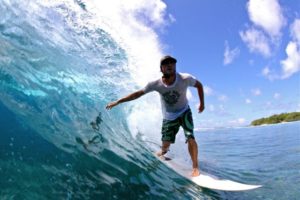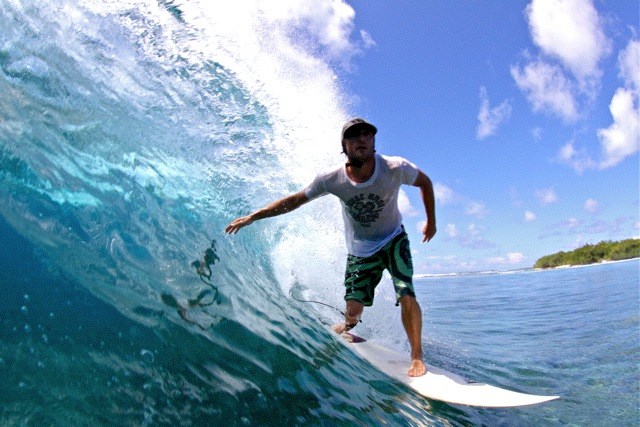 Since around the ’60s, surfing has become a popular recreational past time. For many, it is about the relaxation and peace found whilst out on a board, and for others, it is chasing that perfect ride. Surfing is definitely a sport of leisure but it is the amazing health benefits of the sport, which has inspired this article. Below I introduce my SURFS-UP points for healthy reasons to grab a board.
Since around the ’60s, surfing has become a popular recreational past time. For many, it is about the relaxation and peace found whilst out on a board, and for others, it is chasing that perfect ride. Surfing is definitely a sport of leisure but it is the amazing health benefits of the sport, which has inspired this article. Below I introduce my SURFS-UP points for healthy reasons to grab a board.
- Surfing can be a great way to stay in shape and lose weight. Australia as a nation has an ever-increasing belt size. Recent statistics show that about 1 in 4 Australian adults fall under the obese category according to body mass index (BMI). Keeping in mind that BMI does not take into consideration muscle mass, this is still an alarming statistic. I must admit I take solace in the fact that around 55% of Australians are actively trying to lose weight. Surfing can be an extremely strenuous form of physical activity. Considering currents, rips, waves and trying to stay afloat on a buoyancy device, surfing can really give the body a great workout, and that’s just to get out past the break! Whilst trying to catch a wave, explosive bouts of energy are required, which can be a great form of high-intensity training.
- Utilizing the cardiovascular system. Everyone in Australia is well aware of the importance of cardiovascular fitness. Numerous health campaigns and initiatives are in place that creates awareness of the dangers of the leading cause of death in Australia, cardiovascular disease (CVD). Surfing incorporates both the aerobic and anaerobic energy systems. Paddling out in the surf takes aerobic endurance which means the heart needs to supply the muscles with the higher oxygen demand in order to perform the activity. Continued utilization of this system leads to a healthier heart with greater oxygen delivery capabilities. A 2005 review found that surfers have a higher oxygen uptake (VO2 Max) compared with other athletes. The Australian heart Foundation recommends 30min of physical activity a day to reduce the risk of CVD and I couldn’t think of a better way to achieve this than heading out for a wave.
- Revitalizing and relaxing after a hard week of work. It is a fact that 1 in 5 Australians will experience depressive episodes or depression in their life. Unfortunately, depression often flies under the radar. Stress is one of the many causes of depression, especially long-term stress. Stress can come from many sources with work being a major player. It is important to take time out of your day and week to reward yourself for all the hard work. Surfing provides a great way to unwind and forget about all the deadlines, emails and paperwork. It is important to maintain a healthy balance of work and leisure. For more information on mental health visit: www.mentalhealth.asn.au
- Flexibility of the spine. This one is a good one for the guys!! Most females have quite good range of motion and general flexibility of their spine, which can aid in reducing injuries. Blokes, on the other hand, don’t. This isn’t to say all guys are not flexible and all girls are, but generally speaking, we are behind on the flexibility scale. During a surf there is a great amount of flexion, extension and rotation throughout the spine. To pop up takes extending through the spine and to turn during manoeuvres takes a combination or flexion and rotation. Surfing increases this flexibility over time, reducing the risk of injury.
- Stabilisation of the spine. Spinal stabilization is something that osteopaths, chiropractors, physiotherapists and the like, attempt to facilitate. Co-contraction and facilitation of the core stabilizers and back extensors can be a hard thing to master yet is so important for spinal health, control and stability. Surfing takes great control of the deep abdominal musculature. From sitting on the board waiting for the next set, to balancing whilst riding the wave, the core muscles are activated at quite high levels. This core strength training aids spinal stability thus reducing the risk of episodic back pain.
- Upper body strength. For all those gym junkies out there training for those “guns” and broad shoulders, grab a board and head out. Paddling out exerts a massive force on the upper body and studies show that the heart rate whilst paddling out resembles a high-intensity workout at the gym.
- Proprioception and co-ordination. Don’t let the word proprioception scare you. It merely means the centres of the body, which sense change to the body’s position and thus subconsciously adjust in order to maintain balance and coordination. It is no surprise that this aspect of health made the list. Surfing requires a great amount of balance and control, which is coordinated by our proprioceptive areas. In a 2009 study, researchers examined the effects of long-term surfing on control, posture, balance and joint position sense in the elderly and compared this with a population of similar age that had never surfed in their life. The results were not surprising that the surfing group had greater proprioception and control, however, what this highlighted to me was the importance of proprioception for this age group. Falls are among the major causes of hospitalization of people in the over 65 population. The results of this study show that lifelong surfing can aid in proprioception and control thus reducing the risk of falls as we age.
Article written by Dr Michael Smith (Chiropractor)
References:
Australian Heart Foundation (2014) http://www.heartfoundation.org.au
Borghuis, Jan, Hof, AT L. & Lemmink, Koen A.P.M. 2008. The Importance of Sen- sory-Motor Control in Providing Core Stability. Implications for Measurement and Training. Sports Medicine 2008: 38(11): 893-916.
Filipa, Alyson, Byrnes, Robin, Paterno, Mark V., Myers, Gregory D., Hewett, Timo- thy E. 2010. Neuromuscular Training Improves Performance on the Star Excursion Balance Test in Young Female Athletes. Journal of Orthopaedic & Sports Physical Therapy. September 2010. 40(9): 551-558.
Méndez-Villanueva, A; Bishop, D 2005. Physiological Aspects of Surfboard riding Performance. Sports Medicine: 35(1):55-70.
Méndez-Villanueva, A; Perez- Landaluce, J; Bishop, D; Fernandez-García, B; Ortolano, R; Leibar, X; Terrados, N 2005. Upper body aerobic fitness comparison between two groups of com- petitive surfboard riders.
Mental Health Association NSW (2014) http://www.mentalhealth.asn.au
NSW Government: http://www0.health.nsw.gov.au/resources/publichealth/hsnsw/pdf/falls_health_statistics_r.pdf

